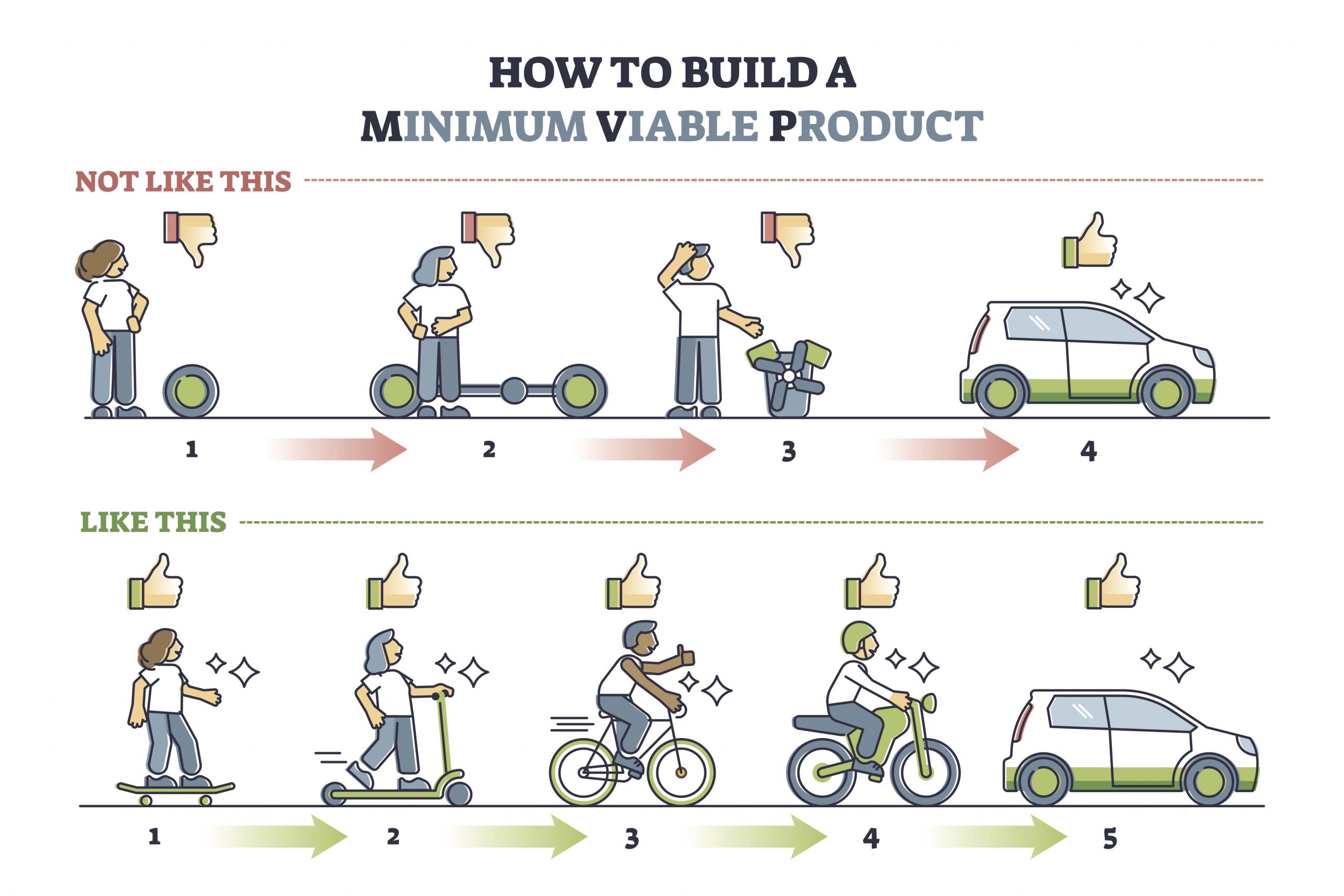Bring an MVP to your Next Sales or Martech Implementation
Author
| Published: March 31, 2022As a company that’s implemented or evolved dozens of sales and marketing systems for growing companies, we’ve learned it’s better to give people less than more. Yes, that’s right; we isolate the most useful features and launch a Minimum Viable Product (MVP) solely for the users that can benefit the most.
Sound weird? Read on to find out why we recommend an MVP approach with virtually all our implementations – and why you should too.

The paradox of choice
We had to replace our car a few years back. After always driving second-hand cars, I was excited to finally shop for something new. Which brand should we get? Gas, electric, or hybrid? Heated seats? Blind spot cameras? Upgraded stereo? Memory seats? We had to find features that worked for me, my partner, and our two kids.
I started my research. But my anticipation turned to confusion, then hesitation, and ultimately, a kind of paralysis. With all the features, I found it impossible to do an apples-to-apples comparison between cars. We ultimately ended up purchasing a used Honda; not because we loved it, but because we were 100% clear what we got for an exact price. This is referred to by psychologist Barry Schwartz as the paradox of choice.
Feature overload
We see this same behaviour when people choose and use their company’s martech and salestech software. Whether HubSpot, Salesforce, Marketo or specialized tools like Mailchimp, these powerful tools have tons of features to help with growth. After a system is in place, it’s natural to roll out the maximum number of features to all potential users. “Let’s use all the things!” as my colleague Laurie Smith says.
Thing is, the rapid deployment of maximum features to all users nearly always fails. Why?
People get overwhelmed. When presented with an overflowing cup of options, they get stuck. They confuse one feature with the next and become frustrated. Rather than choosing or doing the wrong thing, they put it off long enough and forget their training. Or they don’t take action at all. Unless it’s specifically relevant and urgent to them, they won’t use it.
So when it comes to a new system, urging a large group of people to do 20 new things all at once just doesn’t work. For even the techiest keeners at a company, it’s all too much.
Enter the Minimum Viable Product
At Inflectiv, we take a different approach. We roll out a Minimum Viable Product, or MVP, as the first release for all new CRM, salestech, or martech implementations. Rather than taking months (or years) trying to build the perfect all-in solution, the idea behind the MVP is to build a usable product quickly.
The MVP won’t use all the product’s bells and whistles at first, but it will meet the most pressing needs. Most importantly, people will use it and you can get feedback for future (potentially fast) iterations. The MVP is a cornerstone of lean and agile methodology that software companies have used for decades.
Wait, what? But, you might think, MVPs are usually for new software builds!
Why would you deploy an MVP for a mature product like HubSpot or Salesforce?
The answer is simple. Even the most advanced salestech and martech product is half finished out of the box. “Finishing” these products is the process of tailoring it to the needs of each business that uses it. So, the MVP that Inflectiv would want to ‘stand up’ quickly contains the fewest, most important features, uniquely tailored to meet the needs of the smallest, most important user group at the client company.
Ok. So how do you go about creating an MVP?
Discovery. Like everything, it starts with a thorough understanding of company needs. What people, processes, and platforms are you using now? What are the pain points? What’s working well? Where is the need strongest? Where does it make sense to start? This is ideally done long before a new product is purchased, but it can really happen at any time.
Strategy. Turning all the lights on at once is not a strategy. At the end of the day, the strategy outlines how to spend the least resources to achieve the greatest impact. What are all the things that need to happen before we go live? Usually new tools require business inputs and decisions, such as the ideal buyer’s journey, to be worked through and decided before they appear in a tool. Remember that every company is unique; the system that may have been perfect at your last job may not make sense at your next one.
The strategy also outlines the roadmap for rollout. What should the scope be for the initial MVP? Again, you’ll want to look at which group will get the most value for the least resources. Make a plan for eventual introduction of features not included in the MVP: what will your future releases include? We like to use the rollout framework of crawl/walk/run.
Implementation. It’s vital to only mobilize your new tool to the right people at the right time. Start by striking an implementation committee. Make sure actual marketing, sales, finance, and other users are involved in the discovery, review the proposed solution, and do the initial testing. Remember that the people who approved the product purchase may not be the right people to get in the weeds on how it is used.
And just as importantly, make sure to exclude those not essential to the MVP implementation until they are needed. As long as you have accounted for these users in the roadmap, and you are clear when you will come back to them, they will appreciate being freed from non-essential meetings.
Launch.If you’ve kept the scope tight and included the right people along the way, the launch of the MVP should be a non-event. That’s a good thing; it means you’ve already addressed their primary issues.
Once you go live with the MVP, you’ll want to stay close to the team using it. What’s working? What’s not? Any surprises? Capturing bugs and feedback, and then addressing issues promptly, will help you ensure the MVP delivers the value it promises.


Generate momentum from the MVP
A major output of your MVP launch will be momentum. Your core users should be excited about how the system saves them time or helps them achieve better results. Be sure to share their enthusiasm across the company so you can move on to future phases.
Pro tip: if they are not enthusiastic about the MVP, do not move on to future phases. Pause and find out what the issue is. Try to fix it, whether you can do right away or in a future release.
Iterate for future releases
While the MVP is an important first step, you should never stop there. After a successful launch your users will be comfortable with the tool and sales or marketing data will be in the system. Now you are in a better position to add more capabilities to what’s already been rolled out, such as automations, transformations, or integrations. Or consider rolling out adjacent features or reporting that will add value to the process. Following your MVP, you’ll want to get in a regular release cycle based on a long-term roadmap, just like the product managers do.
Eight cornerstones to building your growthtech Minimum Viable Product (MVP)
- Do the legwork and listen. What are the requirements? What are the biggest pain points? What can you automate, accelerate, or solve with the new system?
- Isolate the quick wins and do them first. Sometimes rolling out the simplest thing, such as the HubSpot meetings tool or an accurate list of customers, can have the most impact and get your momentum going.
- Be ruthless with the scope of your MVP. Are the 15 things three teams want to do with the system truly essential? Don’t be afraid to do less at first, provided it truly makes an impact.
- Show the roadmap. Ensure all the organization’s revenue operations needs for the product are sketched out in a longer-term roadmap. It can be high level, such as crawl/walk/run. Showing when the other teams will go live or get access will help ensure buy-in for your MVP launch.
- Train, train, train. Even the simplest MVP requires extensive training for your new users. Develop custom training materials with screen shots, detailed instructions, and examples. Following the training, provide a forum for questions on Slack or Teams and consider making yourself available for regular office hours so people can drop in for help.
- Address MVP feedback quickly. Stay close to the team of users during the launch period to plug gaps and make changes. Do not let them flounder! Consider bug-tracking software or surveys to capture feedback that may not come across in meetings.
- Account for behaviour change. Not everyone will take to it right away, as per our earlier post about communications for platform implementations. Be sure to show the win-win and use both carrot (feature that directly benefits users) and stick (mandatory action that directly benefits management) to drive adoption.
- Start working on v 2.0 right away. Enhancing your new product should never stop. If the MVP launch is going well, move on to the next phase from your roadmap. If you’ve learned things from the MVP launch that changes the roadmap, be sure to adjust accordingly.
As the saying goes: if you try to be everything to everyone, you end up being nothing to no one. Don’t let that happen to your company’s martech or salestech solution. Start by bringing in the MVP.

